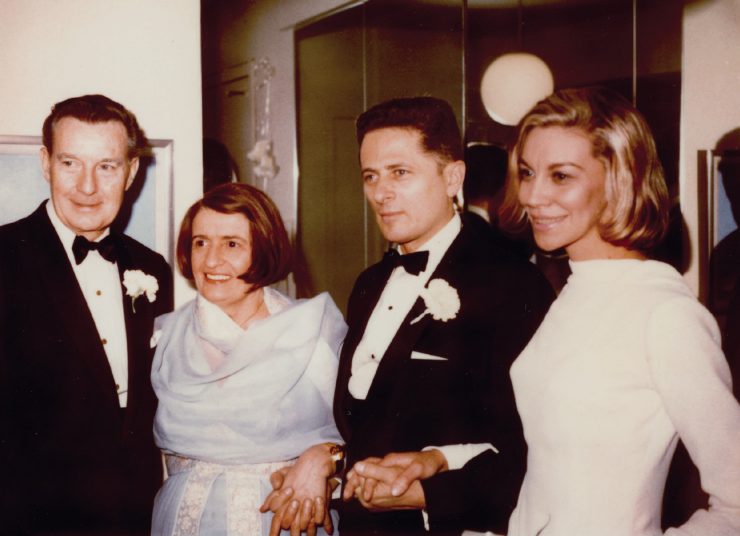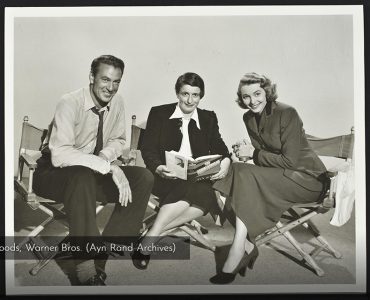In 2001, the Ayn Rand Institute Press published Facets of Ayn Rand: Memoirs by Mary Ann Sures and Charles Sures, based on forty-eight hours of interviews conducted through an oral history program from September 1998 to January 1999. More than twenty years later, these entertaining and informative personal reminiscences still merit careful study and reflection. New Ideal is proud to present the entire book online in eight installments.
INTRODUCTION BY LEONARD PEIKOFF
Mary Ann and Charles Sures were longtime personal friends of Ayn Rand — Mary Ann for twenty‐eight years, Charles for almost twenty. Their recollections in this delightful memoir make vividly real the Ayn Rand they knew so well.
Their book offers plentiful examples of Ayn Rand’s mind, and intellectual generosity, in action, and also captures many lesser‐known aspects of this unique woman. In these pages, we see Ayn Rand the celebrity, the loving wife, the legal client (of Charles), the employer (of Mary Ann). We are with her in her study (including the day she wrote the last page of Atlas Shrugged), at stamp shows, at the opera, on a New York City transit bus, in the White House. We discover new examples of her favorite and least favorite things in clothes, perfume, parties, music. We relish again her sense of humor, her capacity for indignant anger, her benevolence.
The Sures understand and admire the passion for values from which Ayn Rand’s anger stemmed. In Mary Ann’s words, she was someone “who always speaks out, unequivocally, against irrationality and injustice, and who not only denounces evil, but who defends the good. She was mankind’s intellectual guardian, a soldier in the battle of ideas. Her banner was always flying high. When she died, someone made the following comment: ‘now anger has gone out of the world.’ And I thought, it’s true, and it’s the world’s loss, and mine.”
As to Ayn Rand’s response to the good, Mary Ann describes some eloquent scenes, such as: “I had heard that when [Ayn’s] ship reached the pier [from Russia], tears ran down her face as she looked up to the skyline of New York. I asked what those tears were for. Frank answered: ‘They were tears of splendor.’ And Ayn nodded in agreement.”
The unique quality of these memoirs is not only the new content they reveal, but also the perfect balance they achieve among ideas, emotions, and actions, including where appropriate specific dialogue and physical, perceptual details. The result has almost the impact of fiction, specifically of Romantic characterization. From the book one gains not a mélange of random memories, abstract ideas, and disconnected concretes, but rather the experience of an actual larger‐than‐life person.
The person in this book is the same person I myself knew for so long; reading these pages is almost like having Ayn Rand in the room again. The result on me is partly sadness that the irreplaceable is gone, but mostly exhilaration that she once was real.
Admirers of Ayn Rand owe a debt of gratitude to the Sures for their dedicated work in putting this compelling material on record. They finished the manuscript just before Charles died last December. He spent considerable time during his last weeks and even days in editing and polishing his parts of the book. Knowing how near he was to death, he still said to Mary Ann: “It’s one of the most important things we have ever done. We have to make it just right.” This is the kind of heroism before which one stands hushed, in farewell salute.
Ayn Rand and her husband would have grieved at Charles’s death. I know this because I know the values they shared, and what friends the four of them were. The Sures were among the few people in Ayn Rand’s life who were intellectually honest all the way down: they accepted her philosophy, they lived by it, they remained loyal to it and to her throughout her life and theirs. Thus the special feeling Ayn Rand communicated whenever she spoke of them.
Those who want to know more about the author of The Fountainhead and Atlas Shrugged now have a new opportunity to do so — thanks to the loving memories of two lovely people, Mary Ann and Charles Sures.
Irvine, California
March 2001
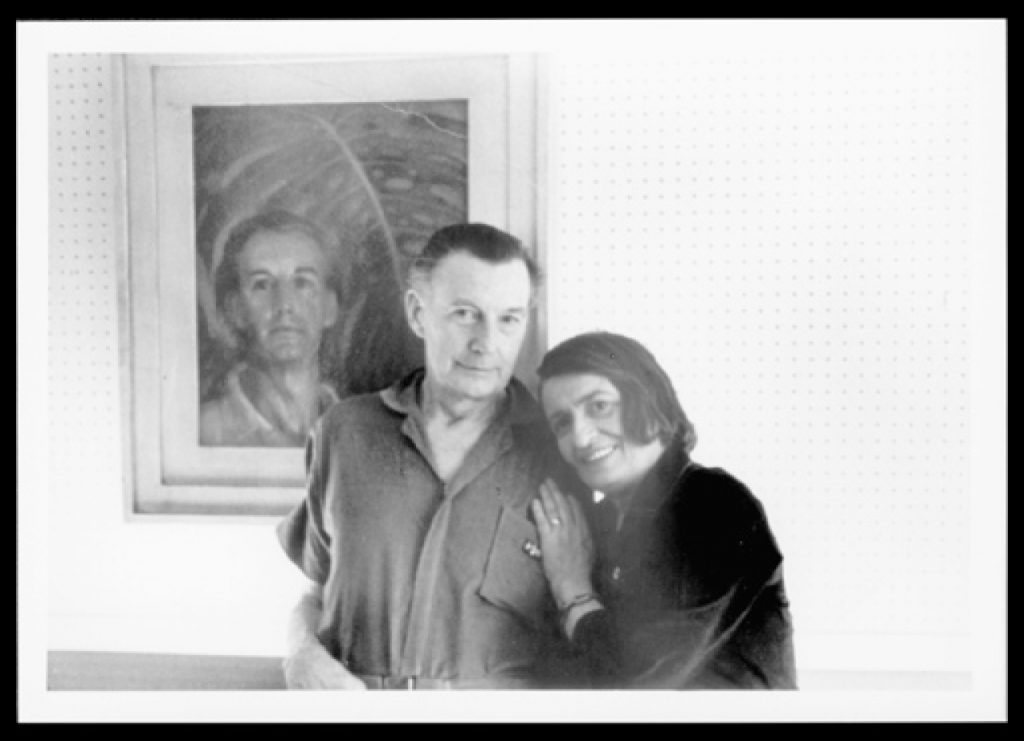
OUR APPROACH TO THESE INTERVIEWS
ARI: What is your purpose in doing these interviews?
MARY ANN: We want to preserve our recollections of Ayn Rand and our evaluation of her. Few people knew her for as long as we did — I for twenty‐eight years and Charles for almost twenty. She was an extraordinary thinker and person, and we knew her in both capacities. In the years to come, people will be asking the same question they ask about her today: what was Ayn Rand like as a person, in her private life? We can answer that question.
ARI: Is part of your reason to pay a debt of gratitude to her?
CHARLES: That’s part of it. What we, and many, many others, owe to her is incalculable. But, in addition to that, we have read things about her that give a distorted picture of what she was like. We want to correct the record. It should be said here that we are not referring to Leonard Peikoff’s essay, “My Thirty Years with Ayn Rand: An Intellectual Memoir.”1 That is a brilliant analysis of her thinking methods, and it captures the spirit of Ayn Rand the philosopher and person.
We have read things about her that give a distorted picture of what she was like. We want to correct the record.
ARI: Why do you think people are so interested in knowing about Ayn Rand the person?
MARY ANN: I think it’s akin to falling in love with someone. When you do, everything about that person becomes important to you. From his basic outlook on life to small details. For the same reason, but not with the same intensity, people who have come to value Ayn Rand through her writings want to know more about her. That’s a legitimate interest, motivated by the desire to give reality to the person they admire but know only as an abstraction — as “philosopher” and “fiction writer.”
CHARLES: I should add that this is not what motivates today’s tabloid mentalities. They look for flaws and shortcomings, for weaknesses. They debunk greatness, to get at what they claim is the “real” person. This is a miserable outlook on man and life; it reflects the medieval view that man is imperfect by nature.
MARY ANN: We are concerned with the woman who defined the philosophy of Objectivism, who let us enter the bright, shining worlds she created in The Fountainhead and Atlas Shrugged, who straightened our intellectual spines and made it possible for us to lift our heads and look up and out, and to step forward into great distances with certainty and conviction. That’s the woman we are going to talk about. That is the “real” Ayn Rand.
CHARLES: Ayn Rand was a rare, one‐of‐a‐kind, multi‐faceted jewel. We want to hold some of those facets up to the light.
CHAPTER ONE
AYN RAND AND MARY ANN SURES
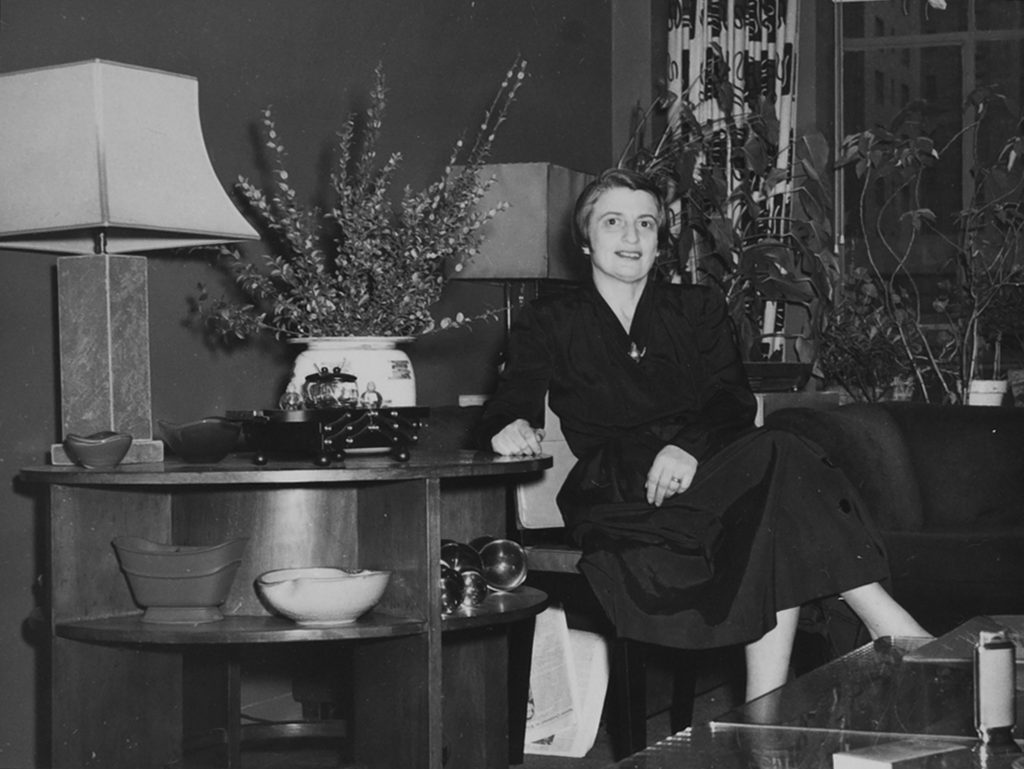
MEETING AYN RAND
ARI: Where, when, and how did you meet Ayn Rand?
MARY ANN: I met her in New York, sometime in the fall of 1954. The occasion was an oral examination on her philosophy.
ARI: In those years, where did you have the opportunity to study her philosophy?
MARY ANN: Privately, with Leonard Peikoff, who was then a graduate student in philosophy at New York University (NYU). Here’s the background, briefly. At the time, I was an instructor teaching art history at New York University, Washington Square College, while pursuing a Master’s Degree in art history at NYU’s Institute of Fine Arts. An acquaintance I met in graduate school, Joan Mitchell,2 gave me a paperback copy of The Fountainhead. We had been discussing art history as a career choice, and I told her that I had been criticized for studying art when there were starving people in the world whom I should help. I didn’t agree with that attitude, but I didn’t have convincing arguments against it. Joan said that I would find the answers in that novel. I did, and I loved the book.
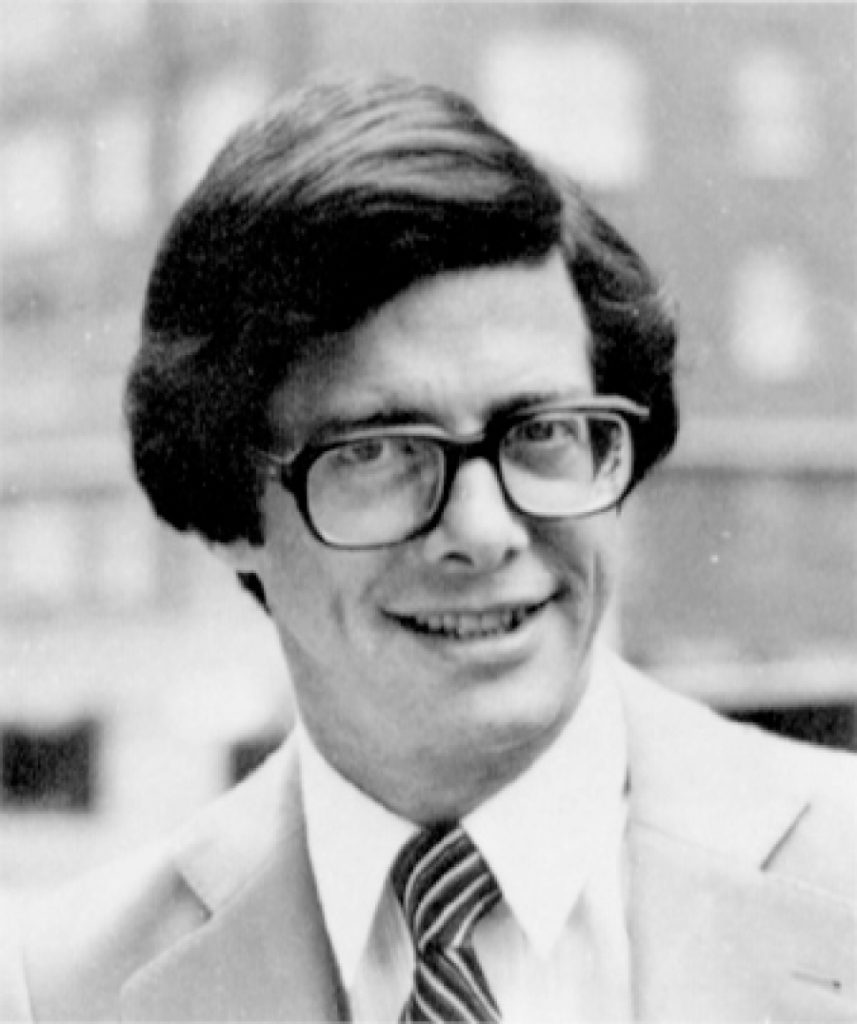
Joan, who had met Ayn Rand some years earlier, introduced me to Nathaniel Blumenthal3 and his wife, Barbara, who were close friends and admirers of Ayn and her writings. They were graduate students at NYU, he in psychology, she in philosophy. Nathan wanted to meet people interested in and in agreement with the ideas expressed in The Fountainhead. I also met Leonard Peikoff, another admirer of Ayn Rand. Since Leonard wanted to teach philosophy, Nathan suggested that it would be good experience for Leonard to give private lectures on Ayn Rand’s philosophy to a few people, including me. This was Leonard’s first course on Objectivism, although it wasn’t yet called “Objectivism.” He gave some of the lectures in Joan’s apartment. It was an informal set up.
ARI: What topics did he cover?
MARY ANN: He explained what philosophy is, and then focused on metaphysics, epistemology, and ethics. He explained the Law of Identity, causality, sense perception and reason, altruism, man’s life as the standard, the benevolent universe concept.
ARI: Had you studied philosophy before this?
MARY ANN: Very little. I had had a bad experience in an introductory college course in philosophy. The professor, a Platonist, made philosophy obscure and unrelated to living. Leonard’s lectures were the opposite: he made the ideas clear, and he showed the relevance of philosophy to life. I typed up my notes and went over them with Leonard to make sure I understood everything. He was a dedicated teacher, even then. Incidentally, I kept those notes for more than thirty years, along with my first paperback copy of The Fountainhead — until the book and the notes crumbled and fell apart.
When the lectures were finished, it was decided that there would be an exam and that it would be oral and held one evening at the home of Ayn Rand. I learned later that she suggested it.
ARI: Didn’t you feel intimidated about the prospect of meeting her under those conditions?
MARY ANN: No. I had read and reread The Fountainhead and I had studied my notes from Leonard’s lectures, so I felt prepared. That’s one reason I didn’t go there with butterflies. But the main reason has to do with my perspective and context then. When you or I say “Ayn Rand” today, we think of a genius, an intellectual giant: the creator of the philosophy of Objectivism, the author of Atlas Shrugged, The Fountainhead, and We the Living, the writer of an impressively long list of brilliant articles, essays, and lectures. But, when I met her in 1954, the context was different. She was still writing Atlas Shrugged; the essays and lectures were yet to come; her classic Introduction to Objectivist Epistemology was twelve years away; We the Living, which I had not read, was out of print. Yes, she was then a genius, an intellectual giant. Only I didn’t know it. I had read only The Fountainhead, and I wanted to learn more. So, when I went to the exam, I was eager, naive, and ignorant, but not nervous. I had no idea of how extraordinary a person she was. Of course, by the time the evening was over, I did.
When she discussed ideas, there was an urgency, an exhilaration in her manner. She was concerned with truth, the whole truth, and nothing but the truth.
ARI: What do you remember of that evening of more than forty years ago?
MARY ANN: I’ll say first that in one’s lifetime, there can be events of such significance that they are never entirely forgotten. Meeting Ayn Rand is in that category, and my memory of aspects of the evening is still fresh. Also, in those days, I kept a diary of sorts; I recorded my impressions of that night.
I was the first one to arrive; Frank [O’Connor]4 admitted me to the apartment and, after saying that Ayn would be out shortly, left me alone in the living room. It was a long room lit by lamplight falling on glass‐topped end tables and comfortable, clean‐lined furniture. I walked over to the window; the drapes were open, and there were no buildings nearby to interfere with the view toward downtown Manhattan. For a few minutes, I stood at the window. Then I heard a sound behind me, and a voice said, “Hello.” I turned around, and there was Ayn Rand.
I had imagined someone quite different, someone tall, blonde and slender, like a fifty‐year‐old Dominique,5 someone reserved in manner, even a little bit aloof. But she wasn’t like that at all. She was shorter than I expected,6 and her hair was brunette. There was nothing aloof in her manner. When I turned, she had the nicest, friendliest smile. She was standing in the middle of the room, so I walked over to her and introduced myself. We shook hands, and she commented on my name being Russian with the feminine ending. I was Mary Ann Rukavina then. I remember only two things about our first conversation: I told her that I had thoroughly enjoyed The Fountainhead. She thanked me and asked if there were parts or characters that I especially liked. I answered, “The boy on the bicycle.”7 She smiled broadly. That was how we met. It was very simple, very natural.
She was wearing a navy blue outfit — a skirt and jacket, with a blue and white polka dot blouse. I learned later that it was an outfit designed by Adrian.8 She wore high heels. She had a simple hairstyle, with a touch of the dramatic — a short, straight bob that angled across her forehead. Her eyes were deep brown, large and luminous, wide open. They were always like that; she never seemed to squint. Soon, others came and the examination started.
ARI: Who was running it? Who was there?
MARY ANN: Leonard was in charge — he was the professor. Joan and I were the only students. Frank, Barbara, and Nathan were there, as observers, along with Ayn.
ARI: What do you remember about the exam?
MARY ANN: I don’t remember all the questions, but there were some on the Law of Identity, and on causality. Joan and I took turns and added to each other’s answers. We did well.
I remember one episode very well, because Ayn was speaking directly to me. I was having a problem with an issue in metaphysics, which was a new field for me. Ayn could tell from one of my answers that I didn’t understand the distinction between “attribute” and “entity.” She sat on an oversized couch that was covered in plaid tweed. I can see her there now! There was a rectangular chrome‐and‐glass‐topped coffee table in front of her. Using the table as an example, she explained the distinction to me. She explained that the “length” of the glass top was an attribute, which couldn’t exist apart from the “entity” glass top; and she discussed the height, width, and smoothness of the glass, explaining that they were also attributes.
She was like fresh water, in unlimited supply, made available to a person dying of thirst.
A few times, she stopped her explanation to ask me if it was clear to me. She said she wanted to make sure I understood one point before going on to the next one. Without realizing it, each time I grasped a point, I smiled. And she asked me why I was smiling, and I answered that I was happy to understand it. And then she smiled in response.
That night, I learned two things about her that were true of her all the years I knew her: one, she took ideas seriously, and two, it mattered to her that her listener understood her. Her knowledge was vast, her context was broad, but she could explain complex ideas in a manner that could be understood by someone without that knowledge and context. And when you grasped a point, she was pleased and she showed it.
Some years later, we were discussing one of her favorite television series, Perry Mason, and she commented on how much she liked Raymond Burr’s facial expression in the introductory credits. He is in a courtroom, holding a legal document and looking thoughtful. Then he begins to smile, slowly and knowingly. Ayn said that he looked as if he had made a mental connection, had understood something, as if a light bulb had been turned on in his mind. For her, observing a mind following an argument and making mental connections was like seeing a light bulb go on in the mind of her listener — and this was a source of great pleasure for her. I responded to this aspect of her that night, and I valued it throughout our friendship. She never changed.
ARI: How would you describe her general manner?
MARY ANN: She was intense about the importance of ideas, and she was intensely focused when explaining them. But what came across was this: to deal with ideas, to communicate them, to understand them — this is the most natural thing in the world for people to do. She spoke from the premise that philosophy is everyone’s business because it affects everyone’s life; it is not some dry, esoteric subject taught by disillusioned professors. By her tone of voice, her way of looking directly at you when she was speaking, she let you know that she was explaining an idea to you, to you personally, and that it was vital that you understood it.
ARI: What else impressed you?
MARY ANN: Something she conveyed that was unusual. Here was a person who really cared if an idea was true and right. She was not a disinterested philosopher. Truth mattered to her, not just intellectually, but emotionally. When she discussed ideas, there was an urgency, an exhilaration in her manner. She was concerned with truth, the whole truth, and nothing but the truth. That was a rare attitude.
ARI: Rare, in what respect?
MARY ANN: Other people might be concerned with impressing you with the extent of their knowledge, or with their status in your eyes, or with being a celebrity, or with any number of things irrelevant to the subject under discussion. Not Ayn Rand, not that night, or ever. Nothing got in the way, nothing interfered with her focus on what was true, no matter what the issue was. She made it clear that we were there for one reason: to understand issues in philosophy and learn what was true and what was false.
But there was something else about Ayn Rand that was different from anyone I had ever met before. I felt myself responding to this “something,” but I didn’t know what it was. It wasn’t until after a few more meetings with her that I could name it.
ARI: What was that?
MARY ANN: She had certainty. This is what really attracted me emotionally to her that night. She was the first person I had ever met who projected it — she projected that what she knew was true, and that she was sure of it.
What she was that night was the way she always was: she never doubted herself and her capacity to understand. It’s not that she had an encyclopedic mind that knew everything — although she knew more about things than most people did. The point is that she didn’t live in a state of chronic doubt. She didn’t constantly question the rightness of her ideas. She didn’t hesitate and flounder. She spoke with conviction. What she knew, she knew. This was a strong element in her personality.
ARI: What did it mean to you, personally?
MARY ANN: She was like fresh water, in unlimited supply, made available to a person dying of thirst. You see, I did not grow up in an atmosphere of religious mysticism. The problem for me was skepticism, although I didn’t know it at the time. I grew up in an intellectual environment that almost everyone grows up in, that communicates one thing: you can’t really be sure of anything. Which is another way of saying that you can’t trust your mind to know reality. Of course, as a child, you could be sure of the multiplication tables in arithmetic, or the correct spelling of a word — things you memorize. But when it came to ideas, to reaching conclusions, to understanding people and judging them — the attitude was, “who can say for sure what is true or false, what is right or wrong?”
Unquestioning agreement is precisely what Ayn Rand did not want. She wanted you to think and act independently.
The problem plagued me throughout childhood and into high school and college. Skepticism in teaching methods led to endless research and reading, to constantly consulting “authorities” who disagreed with one another, to collecting fact upon fact — but never reaching firm conclusions; everything had to be tentative, on principle. Skepticism was everywhere, and some people seemed to resent it if you wanted certainty. Once, in graduate school, I called a work of sculpture “ugly,” and the professor hit the ceiling. How can you be sure, he said, of what is beautiful or what is ugly?
And then I met Ayn Rand. Not only was she certain, but she conveyed that you, too, could be certain of your knowledge, that you shouldn’t accept anything less.
When I got to know her better, I commented on her certainty. And she said, very simply, that if by observation and reason she concluded something was true, then there was no reason for her to doubt it. New evidence might cause her to revise her thinking, but until and unless such new evidence was available, she was firm about the rightness of her conclusions.
ARI: Is there anything else you recall from that first meeting?
MARY ANN: I was impressed with her manner of speaking — she spoke in complete sentences; she didn’t grope for words or examples. There was an economy in the way she used words; she spoke right to the point. She smoked throughout the evening, using a long cigarette holder, and occasionally she used it as a baton to emphasize a point. She had a pronounced Russian accent, but she spoke as someone who is completely at home with the English language. That shouldn’t have surprised me, not after having read The Fountainhead and having seen firsthand her command of the language. But the combination of her accent and the ease with which she spoke English was startling. Later, I learned that she had worked very hard on mastering English. She had been conscientious about studying all the shades of meaning of any word and making her definitions precise.
ARI: How would you describe the general atmosphere of that evening?
MARY ANN: There was a prevailing sense of good will, which was created in large part by Ayn. I’ve talked about her serious attitude, but there was a charming aspect to her, too. Before she commented on my confusion about “attribute” and “entity,” she turned to Leonard and asked him if he wanted to clarify it for me, or if he minded if she did. I was impressed by this — she was respectfully deferring to the professor. He said that she could do it, that he wanted to hear her on the subject. Then, when she concluded her explanation, she turned to him and said, smiling, “Well, how did I do?” — in the manner of a student seeking the professor’s approval. It was delightful. I left that evening knowing that I had never met anyone like her. Now, almost fifty years later, I can still say the same thing.
AYN RAND’S CERTAINTY
ARI: Mary Ann, getting back to your positive response to her certainty. Did anyone ever accuse you of being attracted to her because you wanted an authority figure in your life?
MARY ANN: Yes, I used to hear that frequently — but I haven’t heard it for many years. It didn’t take me long to learn that although it was said as a criticism of me, the real target was her philosophy and her certainty that her philosophy was right.
ARI: Could you elaborate on this point?
MARY ANN: Some critics have tried to turn her certainty into a desire on her part to be an authority in the bad sense, and they accuse her of being dogmatic, of demanding unquestioning agreement and blind loyalty. They have tried, but none successfully, to make her into the leader of a cult, and followers of her philosophy into cultists who accept without thinking everything she says. This is a most unjust accusation; it’s really perverse. Unquestioning agreement is precisely what Ayn Rand did not want. She wanted you to think and act independently, not to accept conclusions because she said so, but because you reached them by using your mind in an independent and firsthand manner. She was adamant about it: your conclusions should result from your observations of reality and your thinking, not hers. Now, she could help you along in that process, and, as we all know, she did. But she never wanted you to substitute her mind for yours.
ARI: Charles, you must have some thoughts on this issue. Why do you think some critics claim the opposite to be the case?
CHARLES: What it comes down to is that they resent her for her ideas. They resent certainty and what it comes from — from holding reason as an absolute, from basing one’s knowledge and conclusions exclusively on observation and thinking conceptually, from holding a consistent, integrated philosophy. She often stressed that last point — that Objectivism is an integrated philosophy, that it cannot be accepted piecemeal, that one cannot take an option on principles of Objectivism and apply them only when and if it is convenient — that is, when they don’t clash with irrational desires and deceptive behavior. Some people attempted to do that. And whenever she saw evidence of it, she did not let it go by. She always named the issue, always called a spade a spade. She made it clear that you can’t have your cake and eat it, too. You cannot say you hold reason as an absolute and then indulge in petty evasions, or go back on your word, or breach contracts, or tell lies to get a value you don’t deserve, or say that everything is a matter of opinion, that everything is relative. When she saw someone doing this, she didn’t let them get away with it. She named what they were doing. She always brought reason and reality back into the picture.
Marquee image: Frank O’Connor, Ayn Rand, Charles Sures and Mary Ann Sures photographed at the Sures’ wedding ceremony in 1965.
Copyright © 2001 , 2022 Ayn Rand Institute; Introduction copyright © 2001 Leonard Peikoff; all rights reserved.
Do you have a comment or question?
Endnotes
- Leonard Peikoff, Epilogue, The Voice of Reason by Ayn Rand, New American Library, 1988.
- Joan Mitchell later married Allan Blumenthal and is known professionally as Joan Mitchell Blumenthal.
- We called him Nathan. He later changed his last name to Branden.
- Ayn Rand and Frank O’Connor were married in 1929.
- Dominique Francon, in The Fountainhead.
- Ayn Rand was about five feet tall.
- The beginning sequence of Part Four
- Gilbert Adrian, a famous Hollywood designer, and his wife, actress Janet Gaynor, were friends and neighbors of the O’Connors in Northridge (formerly Chatsworth), California.


